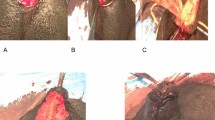Abstract
Object
To evaluate the effects, particularly the incidence of anastomotic fistula, of a pedicled dartos flap around the urethral orifice in the treatment of urethroplasty of mid-shaft hypospadias.
Methods
A total of 46 cases of congenital mid-shaft hypospadias were included in this study. The patients ranged in age from 0.7 to 25.4 years and the average was 5.8 years. The patients received penis chordee correction. A transverse preputial island flap was developed for urethral reconstruction. The proximal dartos of the urethral orifice was used to develop a pedicled dartos flap, which was transposed to cover and strengthen neourethral anastomosis. The ventral penile skin defect was repaired by another flap.
Results
The 46 patients were examined during follow-up visits for 6 months to 3 years. An anastomotic fistula was observed in one case (2.2 %). Scar healing without fistula was observed in another patient due to poor blood supply to part of the ventral penile skin. No other incidences of fistula, urethral rupture, flap necrosis, wound infections, urinary tract (meatal) stenosis, or urethral diverticulum were observed in the patients.
Conclusion
A pedicled dartos flap around the urethral orifice can take advantage of well-vascularized local tissue to add a protective layer to the proximal aspect of the neourethral anastomosis for reducing the incidence of anastomotic fistula in mid-shaft hypospadias repair using a transverse preputial island flap.
Level of Evidence V
This journal requires that authors assign a level of evidence to each article. For a full description of these Evidence-Based Medicine ratings, please refer to the Table of Contents or the online Instructions to Authors www.springer.com/00266.



Similar content being viewed by others
References
Al-Ghorairy BA, Elashry OM, Al-Housain AE, Mattar AA (2009) Analysis of five-year experience with tubularized incised plate urethroplasty for anterior and mid penile hypospadias. Eur J Pediatr Surg 19:90–95
Bertozzi M, Yildiz A, Kamal B, Mustafa M, Prestipino M, Yigiter M et al (2011) Multicentric experience on double dartos flap protection in tubularized incised plate urethroplasty for distal and midpenile hypospadias. Pediatr Surg Int 27:1331–1336
Snodgrass W, Yucel S (2007) Tubularized incised plate for mid shaft and proximal hypospadias repair. J Urol 177:698–702
Yildiz A, Bakan V (2010) Comparison of perimeatal-based flap and tubularized incised plate urethroplasty combined with single- or double-layer dartos flap in distal hypospadias. Urol Int 84:265–268
Babu R, Hariharasudhan S (2013) Tunica vaginalis flap is superior to inner preputial dartos flap as a waterproofing layer for primary TIP repair in midshaft hypospadias. J Pediatr Urol 9:804–807
Bakan V (2009) Dartos flap in Snodgrass hypospadias repair. Urol Int 82:372
Chandrasekharam VV, Jayaram H (2012) Soft tissue covers in hypospadias surgery: is tunica vaginalis better than dartos flap? J Indian Assoc Pediatr Surg 17:141
Erol A, Kayikci A, Memik O, Cam K, Akman Y (2009) Single vs. double dartos interposition flaps in preventing urethrocutaneous fistula after tubularized incised plate urethroplasty in primary distal hypospadias: a prospective randomized study. Urol Int 83:354–358
Ozturk H (2010) Dartos flap coverage of the neourethra following repair for primary hypospadias, reoperative hypospadias and urethrocutaneous fistulas. It is a safe approach. Acta Cir Bras 25:190–193
Routh JC, Wolpert JJ, Reinberg Y (2006) Tunneled tunica vaginalis flap is an effective technique for recurrent urethrocutaneous fistulas following tubularized incised plate urethroplasty. J Urol 176(1578–80):1581
Seo S, Ochi T, Yazaki Y, Okawada M, Doi T, Miyano G et al (2015) Soft tissue interposition is effective for protecting the neourethra during hypospadias surgery and preventing postoperative urethrocutaneous fistula: a single surgeon’s experience of 243 cases. Pediatr Surg Int 31:297–303
Gapany C, Grasset N, Tercier S, Ramseyer P, Frey P, Meyrat BJ (2007) A lower fistula rate in hypospadias surgery. J Pediatr Urol 3:395–397
Chen SC, Yang SS, Hsieh CH, Chen YT (2000) Tubularized incised plate urethroplasty for proximal hypospadias. BJU Int 86:1050–1053
Snodgrass WT (2005) Snodgrass technique for hypospadias repair. BJU Int 95:683–693
Ross JH, Kay R (1997) Use of a de-epithelialized local skin flap in hypospadias repairs accomplished by tubularization of the incised urethral plate. Urology 50:110–112
Tavakkoli TK, Mohammadi S (2010) Tunica vaginalis flap as a second layer for tubularized incised plate urethroplasty. Urol J 7:254–257
Patel RP, Shukla AR, Austin JC, Canning DA (2005) Modified tubularized transverse preputial island flap repair for severe proximal hypospadias. BJU Int 95:901–904
Zheng DC, Wang H, Lu MJ, Chen Q, Chen YB, Ren XM et al (2013) A comparative study of the use of a transverse preputial island flap (the Duckett technique) to treat primary and secondary hypospadias in older Chinese patients with severe chordee. World J Urol 31:965–969
Duckett JJ (1980) Transverse preputial island flap technique for repair of severe hypospadias. Urol Clin N Am 7:423–430
Aoki K, Fujimoto K, Yoshida K, Hirao Y, Ueoka K (2008) One-stage repair of severe hypospadias using modified tubularized transverse preputial island flap with V-incision suture. J Pediatr Urol 4:438–441
Vandersteen DR, Husmann DA (1998) Late onset recurrent penile chordee after successful correction at hypospadias repair. J Urol 160(1131–3):1137
Author information
Authors and Affiliations
Corresponding author
Ethics declarations
Conflict of interest
The authors declare that they have no conflict of interest to disclose.
Rights and permissions
About this article
Cite this article
Liang, W., Ji, C., Chen, Y. et al. Surgical Repair of Mid-shaft Hypospadias Using a Transverse Preputial Island Flap and Pedicled Dartos Flap Around Urethral Orifice. Aesth Plast Surg 40, 535–539 (2016). https://doi.org/10.1007/s00266-016-0659-0
Received:
Accepted:
Published:
Issue Date:
DOI: https://doi.org/10.1007/s00266-016-0659-0




